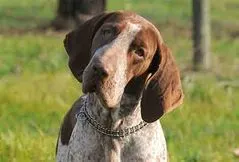
Bracco Italiano
Bracco Italiano has lean limbs, well-developed muscles. They are gentle, loving, obedient, intelligent.
Overall Status
| Height | 21.5 to 26.5 inches |
| Temperament | Affectionate, Intelligent, Enthusiastic |
| Weight | 55 to 88 pounds |
| Life Expectancy | 10 to 14 years |
| Coat Color | White, Orange & White, White & Chestnut, White & A |
| Barking Level | Medium |
Quick Factors
| Playfulness | |
| Dog Friendly | |
| Exercise Need | |
| Grooming Needs | |
| Strangers Friendly | |
| Family Affectionate |
Daily Care
Grooming Tips
The Bracco’s coat is short, dense and shiny. The hair on the head, ears and front of the legs and feet usually has a finer texture. Spend a few minutes once or twice a week brushing the coat with a hound glove to keep it shiny and clean and remove dead hair. Bathe the dog as needed. He might not need a full bath very often, but you may want to clean the ends of his ears regularly. They often get wet when the dog drinks and may pick up dirt when he’s outdoors.Check his ears weekly to make sure they don’t smell or look red or dirty, which could indicate anear infection. Clean them only if they look dirty. The rest is basic care. Trim the nails every week or two or as needed. Brush the teeth often — with a vet-approved pet toothpaste — for good overall health and fresh breath.
Exercise Tips
The Bracco is a moderate- to high-energy breed that requires daily exercise and mental stimulation.This can be accomplished by running free in a safe, enclosed space or by scheduled exercises such as daily jogs.At least 30 minutes of exercise per day is needed, but more is preferred. Furthermore, to be happy, they need time each day spent with their family doing organized training or playing.
Feeding Tips
Given the size of this breed, a high-quality large-breed dog food formula is recommended. If you plan to train your dog for hunting or if he leads an otherwise active lifestyle, choose a dog food formulated for active dogs that will provide for his energy needs.
Health Tips
The Bracco is an overall healthy breed,andresponsible breedersscreen their stock for health conditions such as hip and elbow dysplasia, eye anomalies such asentropion, ectropion, and cataracts, and kidney disorders such asrenal amyloidosis.To avoid orthopedic stresses on their fast-growing bodies, Bracco puppies should be fed a balanced food and should not be run on hard surfaces such as on concrete or perform repeated high-impact exercises until at least one year of age. Check the Bracco’s long, pendulous ears for ear infections, and use a veterinarian-recommended ear cleaner once or twice weekly to keep the ear clean and dry to prevent infections.
Trainability
The Bracco Italiano is a highly intelligent breed. The best training methods for this dog are gentle but consistent – the gentle nature of this dog may make him stop trying if he is treated with harshness or cruelty. For the best results, use positive reinforcement training and start obedience training from a young age.Many fans of the breed will argue that a Bracco Italiano that is not trained to hunt will not be a happy dog. Not only is this the activity the breed was meant for, but the dogs truly enjoy the activity. Even if you choose not to train your dog for hunting, you should provide him with plenty of mental exercises in addition to physical exercise to keep him sharp.
History
The Bracco Italiano can be found in paintings as early as the 4th and 5th centuries BC and frescoes of dogs resembling the modern Bracco date to 14th-century Renaissance Italy. The white-and-orange Bracco is believed to have originated in Piedmont, while the roan-and-brown dogs may have come from Lombardy. The Piedmont dogs, hunting in mountainous terrain, were lighter and smaller than the Lombard dogs, which were bred for working in marshy lowland areas.By the early 20th century, though, the Bracco population had dwindled. Fortunately, an organization called Societa Amitori Bracco Italiano and an Italian breeder named Ferdinando Delor de Ferrabouc revived the breed, partially by uniting the two types to increase genetic diversity. The standard for the breed was released in 1949, and the Federation Cynologique Internationale accepted the breed in 1956. Today it’s not unusual to see the Bracco at Italian events for hunting and working dogs.






